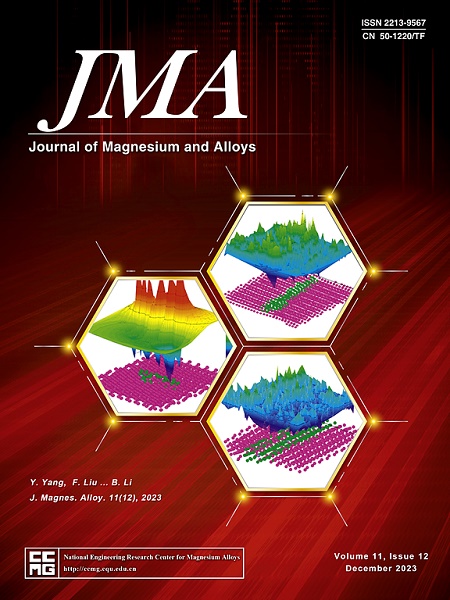可生物降解的磷修饰Mg2Ge/Mg-Cu复合材料具有良好的血管生成,成骨和抗菌功能,用于骨固定应用
IF 13.8
1区 材料科学
Q1 METALLURGY & METALLURGICAL ENGINEERING
引用次数: 0
摘要
镁基复合材料由于其可降解性、与骨相似的弹性模量和生物功能,有望成为生物可降解骨植入材料。然而,它们的降解速度快,生物摩擦学性能差,缺乏血管化和抗菌活性,不利于骨固定的应用。在本研究中,通过磷(P)改性铸造和热挤压制备了一种名义成分为Mg-10Ge-2Cu-0.5P (MGCP)的原位Mg2Ge/Mg-Cu-P复合材料,用于生物可降解骨固定应用。为了比较,在相同的条件下制备了原位Mg2Ge/Mg-Cu复合材料(Mg-10Ge-2Cu,简称MGC),未进行p修饰。在添加胎牛血清(DMEM)的Dulbecco 's Modified Eagle培养基中,通过电位动力学极化和氢释放测试,热挤压(HE) MGCP样品的耐蚀性显著提高,腐蚀速率分别为2.2 mm/y和2.51 mm/y。在DMEM中,HE MGCP的力学性能和生物摩擦学性能也得到了显著提高,σUTS为~ 304.2 MPa, σTYS为~ 202.5 MPa,伸长率为~ 12.3%,σUCS为769.0 MPa, σCYS为208.0 MPa,布氏硬度为105.3 HB,且在Hanks溶液中浸泡3 d后,σTYS和σCYS的下降幅度较小。与纯钛和Mg相比,HE MGCP表现出更强的细胞相容性、血管生成能力、成骨分化和矿化能力。此外,与纯钛和Mg相比,HE MGCP在大鼠皮下植入模型中表现出明显更高的体外抗菌活性、体内抗菌和抗炎能力,并且具有良好的生物安全性,表明其在生物可降解骨固定方面具有重要的应用潜力。本文章由计算机程序翻译,如有差异,请以英文原文为准。

Biodegradable phosphorus-modified Mg2Ge/Mg-Cu composite with good angiogenic, osteogenic, and antibacterial functionalities for bone-fixation applications
Magnesium (Mg)-based composites are expected to be useful for biodegradable bone-implant materials due to their degradability, similar elastic modulus to that of bone, and biofunctionalities. However, their rapid degradation, poor biotribology performance, and lack of vascularization and antibacterial activity are not conducive to bone-fixation applications. In this study, an in situ Mg2Ge/Mg-Cu-P composite with a nominal composition of Mg-10Ge-2Cu-0.5P (denoted MGCP) was prepared via phosphorus (P)-modified casting followed by hot extrusion for biodegradable bone-fixation applications. For comparison, an in situ Mg2Ge/Mg-Cu composite (Mg-10Ge-2Cu, denoted MGC) was prepared under the same conditions without P-modification. The hot-extruded (HE) MGCP sample showed significantly improved corrosion resistance with corrosion rates of 2.2 mm/y and 2.51 mm/y as measured by potentiodynamic-polarization and hydrogen-release testing in Dulbecco’s Modified Eagle Medium supplemented with fetal bovine serum (denoted DMEM). The HE MGCP also exhibited notably enhanced mechanical properties and biotribological resistance in DMEM, with an σUTS of ∼304.2 MPa, σTYS of ∼202.5 MPa, elongation of ∼12.3%, σUCS of 769.0 MPa, σCYS of 208.0 MPa, and Brinell hardness of 105.3 HB, along with smaller σTYS and σCYS decreases after 3 d of immersion in Hanks’ solution. In comparison to pure titanium and Mg, the HE MGCP demonstrated much greater cytocompatibility, angiogenic capacity, and osteogenic differentiation and mineralization capability. Furthermore, the HE MGCP displayed markedly higher in vitro antibacterial activity, in vivo antibacterial and anti-inflammatory ability, and good biosafety in a rat subcutaneous-implantation model compared to pure titanium and Mg, indicating significant potential for biodegradable bone-fixation applications.
求助全文
通过发布文献求助,成功后即可免费获取论文全文。
去求助
来源期刊

Journal of Magnesium and Alloys
Engineering-Mechanics of Materials
CiteScore
20.20
自引率
14.80%
发文量
52
审稿时长
59 days
期刊介绍:
The Journal of Magnesium and Alloys serves as a global platform for both theoretical and experimental studies in magnesium science and engineering. It welcomes submissions investigating various scientific and engineering factors impacting the metallurgy, processing, microstructure, properties, and applications of magnesium and alloys. The journal covers all aspects of magnesium and alloy research, including raw materials, alloy casting, extrusion and deformation, corrosion and surface treatment, joining and machining, simulation and modeling, microstructure evolution and mechanical properties, new alloy development, magnesium-based composites, bio-materials and energy materials, applications, and recycling.
 求助内容:
求助内容: 应助结果提醒方式:
应助结果提醒方式:


